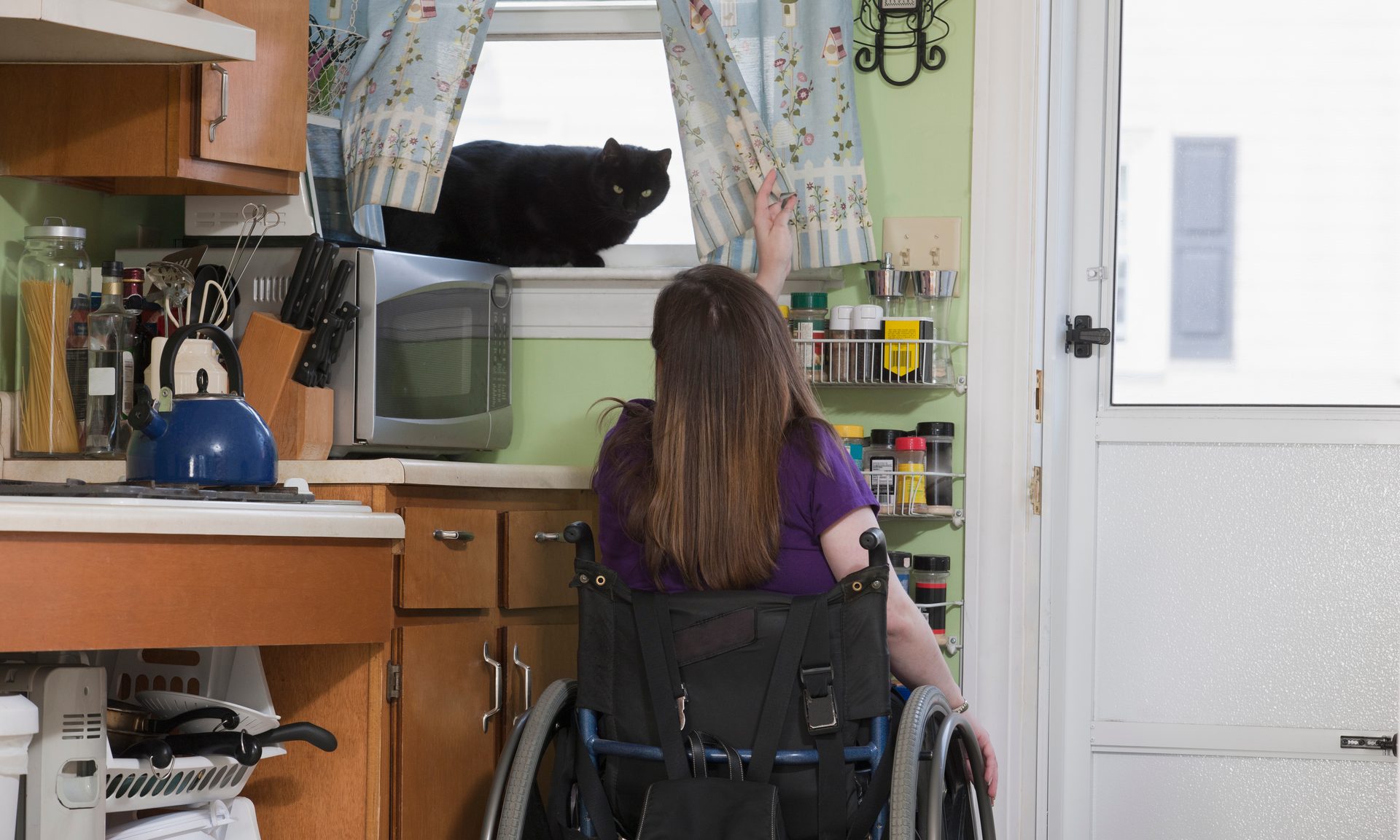Home Modification Grants and Loans for Persons with Disabilities
Grants from the government or nonprofit groups can fund modifications that make homes safer and easier to navigate.

Many, or all, of the products featured on this page are from our advertising partners who compensate us when you take certain actions on our website or click to take an action on their website. However, this does not influence our evaluations. Our opinions are our own. Here is a list of our partners and here's how we make money.
Modifying a home to make it more accessible can involve costly updates. Wider doors, altered kitchen cabinets and a wheelchair ramp can cost thousands of dollars.
Before you finance or pay out of pocket for these upgrades, look for assistance from the government or nonprofit organizations. Many offer resources for people living with disabilities, low-income individuals and service members.
Federal home modification grants
Federal government aid is geared toward military service members and low-income residents of rural areas.
Disability housing grants for veterans
The U.S. Department of Veterans Affairs offers several grants to help service members and veterans modify a home for qualifying service-related disabilities.
- The Specially Adapted Housing (SAH) grant offers up to $121,812 for the fiscal year 2025 (which ends Sept. 30) to help modify a home you will buy, build or change.
- The Special Home Adaptation (SHA) grant offers up to $24,405 for FY 2025 to help modify a home that you or a family member will buy, build or change.
- The Temporary Residence Adaptation (TRA) grant helps modify a family member’s home where you’re temporarily living. You must otherwise qualify for an SAH or SHA grant. TRA grants are up to $49,062 in FY 2025 for SAH-qualified individuals and up to $8,760 for SHA-qualified individuals.
- The Home Improvements and Structural Alterations (HISA) grant provides funds for medically necessary home improvements, including accessibility updates to home entrances and bathrooms. Those with service-related disabilities can get up to $6,800, and those with non-service-related disabilities can get up to $2,000.
Rural housing repair loans and grants
The U.S. Department of Agriculture provides Rural Housing Repair loans and grants to rural homeowners who earn a household income under the “very low income” limit for their county. Grants up to $10,000 are available to homeowners age 62 and older. Loans, which don’t have an age requirement, are up to $40,000, repaid monthly over 20 years at 1% interest. Grants and loans can be combined, according to the department.
State and local home modification grants and loans
State and local agencies may offer more assistance with less restrictive qualification requirements.
- The U.S. Department of Housing and Urban Development’s state information list includes housing and homeownership resources for each state. Many states include resources and grants for home repairs. Information on the state pages varies, but resources are usually listed under a link that references learning about homeownership.
- The Independent Living Research Utilization program has a directory of organizations that support people with disabilities who want to live independently. Some organizations provide funding for assistive technology, including chairlifts and bathroom modifications, while others provide referrals.
- The National Directory of Home Modification and Repair Resources has a list and a map of home improvement resources for older adults and people living with disabilities.
- The Benevolent and Protective Order of Elks offers disability assistance in several states. Ask a local office if it has programs that address your specific needs.
- Lions Clubs International provides donated glasses and hearing aids to those who need them. Ask a club near you about availability.
🤓 Nerdy Tip
Check with your state’s housing department for other financial assistance. Your city or county government may have programs that help with home modifications, including volunteer services and grants. One way to reach them is to call 211. Home modification loans and grants from nonprofits
Nonprofit groups that advocate and volunteer for people living with disabilities can provide funding or assistance at the national or local level. Assistance is often income-based.
- Rebuilding Together is a national organization whose volunteers make homes safer and more livable for low-income families, older adults and people living with disabilities. Qualifications and the type of modifications available vary by location.
- Modest Needs is an organization that provides Self-Sufficiency Grants to those who live just above the poverty level in the U.S. and Canada. The grants cover a range of expenses, including accessible-home modifications.
- Your grant amount depends on your financial situation, but the group says average grants are $750 to $1,250. To qualify, one household member must be employed, and the main source of household income must be from employment, child support, veterans benefits or retirement.
- The National Disability Institute, a group that researches and advocates for people living with disabilities, has a list of organizations across the country that help finance assistive technology.
🤓 Nerdy Tip
Original Medicare covers medically necessary durable medical equipment like wheelchairs and walkers, but not home renovations. Private Medicare Advantage plans may cover some home accessibility improvements for chronically ill enrollees. If you have Medicare Advantage or are considering switching, ask if the plan covers updates to your home and whether you would qualify for that benefit. How to apply for a home modification grant
To prove that you need a modification grant, you may be asked to provide evidence of a disability, as well as information about your income, employer and ownership of the property.
You can make the application process go more smoothly by previewing the requirements and gathering copies of supporting documents before you apply.
Other ways to finance accessible home modifications
If you need to finance a home modification, compare multiple options to find one that fits your budget. Borrowing requirements vary for different types of loans, but your credit score, income, existing debts and possibly the value of your home determine whether you qualify for financing.
The U.S. Department of Housing and Urban Development loans
The U.S. Department of Housing and Urban Development offers two low-rate home improvement loan options:
- The FHA Title I loan is a fixed-rate loan used for projects that improve the “basic livability or utility” of the property — a broad standard that includes accessibility upgrades, according to HUD.
- The FHA 203(k) rehabilitation loan can help you buy a home that needs remodeling or refinance an existing home loan to get extra money for updates. Rates are usually lower than credit cards and personal loans, and loan amounts vary depending on the type of 203(k) loan you get (standard or limited). Credit standards may be lower than a traditional home equity loan or line of credit.
» MORE: What Is an FHA 203(k) loan?
Home equity financing
A home equity loan or line of credit is a low-rate way to finance an update. These loans let you borrow up to 85% of your equity, minus what you owe on your mortgage, and require you to use the home as collateral for the loan.
Home improvement loans
A home improvement loan may be an expensive option, but it can provide fast funding for urgent repairs and modifications. These loans have annual percentage rates from 7.5% to 36%, and borrowers with good or excellent credit (scores of 690 or higher) and high incomes get the lowest rates.
» MORE: Best home improvement loans
Personal loans from our partners
LightStream 

APR
6.49-24.89%
Loan Amount
$5K-$100K
Avant 

APR
9.95-35.99%
Loan Amount
$2K-$35K
SoFi 
APR
8.74-35.49%
Loan Amount
$5K-$100K
Home modification costs
The cost of home accessibility updates will depend on the scale of the project, materials used and labor costs. Here are some common modifications and their costs .
- Elevator: $2,500 to $60,000.
- Indoor stair lift: $1,500 to $5,000.
- Lower cabinets and sinks: $1,500 to $8,500.
- Wheelchair ramp: $1,000 to $4,000.
- Wider doorways: $700 to $2,500 per doorway.
- Grab bars: $100 to $500 each.
Fully converting a bathroom and kitchen to comply with the Americans with Disabilities Act (ADA) guidelines can cost $9,000 to $40,000, but you don’t have to do a full renovation all at once. Starting with the most urgent updates may be easier on your budget.
NerdWallet writer Alex Rosenberg contributed to this article.
Article sources
NerdWallet writers are subject matter authorities who use primary,
trustworthy sources to inform their work, including peer-reviewed
studies, government websites, academic research and interviews with
industry experts. All content is fact-checked for accuracy, timeliness
and relevance. You can learn more about NerdWallet's high
standards for journalism by reading our
editorial guidelines.
- 1. Angi.com. How Much Does It Cost to Make My Home Accessible?. Accessed Nov 12, 2024.
Methodology
How we chose the best personal loans
Our team of consumer lending experts follow an objective and robust methodology to rate lenders and pick the best.

30+
Lenders reviewed
We review over 35 lenders, including major banks, top credit unions, leading digital platforms, and high interest installment lenders operating across multiple states.

25+
Categories assessed
Each lender is evaluated across five weighted categories and 27 subcategories, covering affordability, eligibility, consumer experience, flexibility, and application process.

60+
Data points analyzed
Our team tracks and reassesses hundreds of data points annually, including APR ranges, fees, credit requirements, and borrower tools, ensuring up to date, accurate comparisons.
Star rating categories
We evaluate more categories than competitors and carefully weigh how each factor impacts your experience.
NerdWallet’s review process evaluates and rates personal loan products from more than 30 financial technology companies and financial institutions. We collect over 60 data points and cross-check company websites, earnings reports and other public documents to confirm product details. We may also go through a lender’s pre-qualification flow and follow up with company representatives. NerdWallet writers and editors conduct a full fact check and update annually, but also make updates throughout the year as necessary.
Our star ratings award points to lenders that offer consumer-friendly features, including: soft credit checks to pre-qualify, competitive interest rates and no fees, transparency of rates and terms, flexible payment options, fast funding times, accessible customer service, reporting of payments to credit bureaus and financial education. Our ratings award fewer points to lenders with practices that may make a loan difficult to repay on time, such as charging high annual percentage rates (above 36%), underwriting that does not adequately assess consumers’ ability to repay and lack of credit-building help. We also consider regulatory actions filed by agencies like the Consumer Financial Protection Bureau. We weigh these factors based on our assessment of which are the most important to consumers and how meaningfully they impact consumers’ experiences.
NerdWallet does not receive compensation for our star ratings. Read more about our ratings methodologies for personal loans and our editorial guidelines.
Related articles









